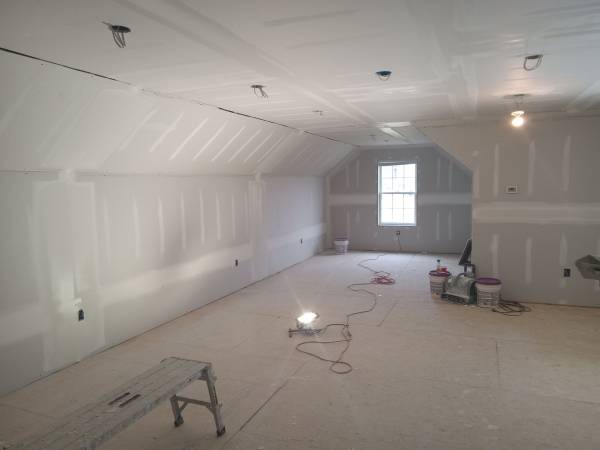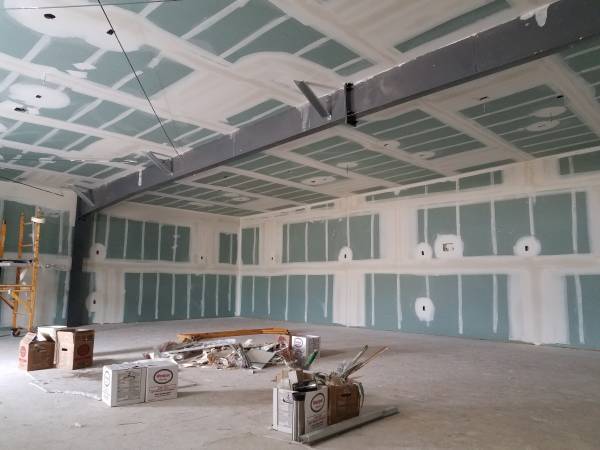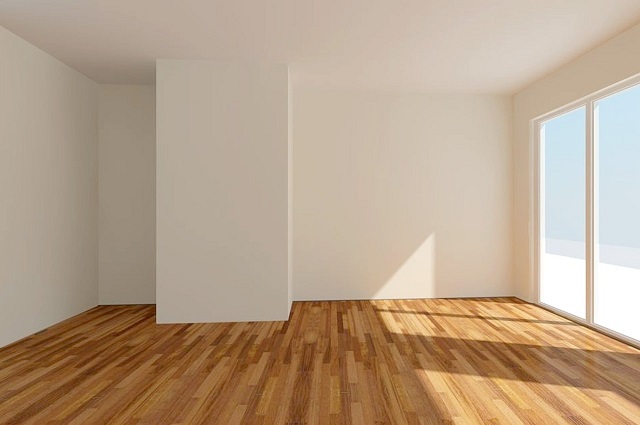Table of Contents
Understanding Drywall Taping
Drywall taping is a critical process in the overall procedure of installing and finishing drywall. It involves the application of a special, paper or fiberglass tape over the joints between panels of drywall. This tape, along with compound or ‘mud’, works to create a seamless look between the panels. The taping process smoothens out any visible lines or discrepancies, enabling a continuous, uninterrupted surface. A skilled application of drywall taping can truly transform an ordinary wall into a polished and refined wall.
The importance of drywall taping can’t be emphasized enough. Without it, the drywall panels’ edges would be visible, ruining the aesthetic appeal of the wall. Moreover, drywall taping also provides a certain degree of strength and stability to the wall. It forms a compound layer that prevents cracking and damage over time. Hence, understanding the correct techniques of drywall taping is vital for anyone involved in drywall installation or repair.
Importance of Quality Drywall Taping
Quality drywall taping contributes significantly to the overall appearance and integrity of the finished wall. It is a process which involves precision and skill, ensuring uniformity across the drywall and providing a seamless surface for painting or wallpapering. A poorly-taped drywall not only mars the aesthetics of a room or a space, but may also expose the underlying gypsum board to moisture, thus compromising the durability of the wall.
Drywall taping is a critical step in drywall finishing that requires expertise, patience, and high-quality materials. The tape acts as a bond that holds the drywall sheets together while also covering the joints, fasteners, and corners. With careful taping rendering a smooth and seamless surface, the final paint job or wall treatment can adhere evenly, ensuring a professional, high-quality finish.
Selecting the Right Tools for Drywall Taping
When it comes to taping drywall, the tools one chooses play a significant role in determining the quality of the result. Among these tools, the most crucial include a sharp utility knife for cutting the tape, an effective taping knife to apply joint compound, a drywall hawk to carry your joint compound, and of course, a good quality drywall tape. Each tool has a specific function that contributes to the overall finish of the drywall task, and thus quality and suitability should never be compromised.
Moreover, for jobs that demand a more professional touch, such as skim coat drywall, specialized tools like a drywall trowel may be required. This kind of trowel helps in spreading the joint compound evenly across the wall and is instrumental in achieving a smooth finish on the drywall. In essence, understanding the task in hand and selecting the required tools accordingly will not only make the job easier but also ensure a professional-grade result. Besides, a wise investment in top-quality tools can last for years, thus making them worth the price in the long run.
Preparing Your Drywall for Taping
For an immaculate drywall taping procedure, the preparation phase plays a pivotal role. To begin with, ensure that the drywall is correctly installed, without any bulging panels, protruding screws or nails, gaps between the panels and that the corners are straight and square. Any imperfections at this stage can compromise the quality of your taping application and consequently the overall look and finish.
Next, consider cleaning and clearing the environment around the drywall. Dust or debris can interfere with the adherence of the tape and may even render your work futile. If there are any large openings or protrusions, patch them adequately before commencing the taping process. Overall, the key to a seamless drywall taping process is a thoroughly prepared and adequate drywall surface ready for the application.
Step-by-step Guide to Applying Tape on Drywall
Before embarking on the task of applying tape to drywall, it is essential that the drywall surface is properly prepared. This includes making sure it’s clean, dry, and free from dust or debris. The first step in applying tape is to spread a bed of joint compound along the seams using a trowel or putty knife – this will act as an adhesive for the tape. After this, the next step is to cut a piece of tape measuring the length of the seam and press it into the compound along the seam. It’s crucial to ensure that the tape is centered over the seam for the best result.
Once the tape is placed, use your putty knife again to gently press the tape into the joint compound. One must work from the center outward to remove any potential air bubbles. Following this, a thin layer of joint compound is applied over the tape. Remember, this process needs to be done for each seam on the drywall. After the first coat is fully dry – which typically takes around 24 hours – additional coats may be applied. Each coat should be wider and thinner than the last, allowing it to blend seamlessly with the wall. This ensures a smooth finish that is ready for prime and paint.
Tips for Smooth Drywall Tape Application
Proper application of tape significantly influences the smoothness of your drywall taping. It’s not just about sticking the tape on drywall; instead, it’s all about the technique used. Firstly, it’s essential to apply an even layer of joint compound before laying the tape. This process provides a consistent base for the tape to adhere to, reducing the chances of bubbles and bumps.
Secondly, whenever you’re applying drywall tape, it’s crucial to use a drywall knife to press down on the tape firmly but gently. This technique eliminates any potential air pockets underneath the tape, ensuring a smooth application. Furthermore, always allow sufficient time for the joint compound underneath the tape to dry before applying another layer of compound over it. The right application process and patience during the drying time can significantly contribute to the smoothness of your drywall taping.
Dealing with Corners and Edges in Drywall Taping
When it comes to drywall taping, corners and edges pose a unique challenge that requires a different approach. These areas often reveal the most visible taping seams, so it’s essential to handle them with precision to maintain the overall aesthetic. Especially troublesome is the inside corner, which is notorious for trapping air pockets that can lead to peeling or cracking over time.
To tackle this problem, a special type of tape, commonly referred to as corner tape, can be utilized. This tape has two flanges separated by a thin metal strip that allows it to bend easily and fit snugly into corners. It’s also essential to apply enough joint compound to these areas to ensure that the tape adheres correctly. Not applying enough compound often results in loose tape and noticeable seams. However, too much can ooze out and make the surface uneven, another hurdle to achieving a smooth finish. Patience, precision, and quality materials are the essential aspects when dealing with corners and edges in drywall taping.
Managing Drywall Taping Mistakes
Even for experts, drywall taping can often lead to occasional errors. Common mistakes include air bubbles in the tape, poor adhesion and potentially unsightly overlap of tape at corners. The good news is, these mishaps are not irreparable. With the right knowledge and tools at hand, identifying these mistakes early is the first step towards remedying them.
Proper preparation is key to preventing drywall taping mistakes. A thin, even layer of joint compound can mitigate the risk of air bubbles. Should they occur, a sharp utility knife can be used to cut the bubble, then reapply joint compound and smooth it out. For issues with poor adhesion, the drywall may need to be lightly sanded and cleaned before a new tape is applied. Overlapping tape, on the other hand, can be avoided by careful measurement and neat trim of the tape edges.
Maintaining Consistency in Drywall Taping
Efficiency in drywall taping is just as much about maintaining uniformity as it is about delivering quality workmanship. Consistency ensures a seamless finish, thus achieving professional results, while staying efficient and reducing the time spent on corrections. It’s crucial to remember a few key principles to maintain this invaluable consistency throughout the taping process.
Firstly, maintaining a steady hand pressure when applying both tape and joint compound is non-negotiable; this takes practice but is integral to ensure uniform thickness across all applied layers. Secondly, cleaning your tools frequently also helps in achieving uniformity as it helps you avoid any unintended ridges that can form due to the dried compound. Lastly, being mindful of the drying times between each layer ensures a bond that’s not only strong but also consistently even across your drywall project.
Achieving a Smooth Finish with Drywall Taping
Creating a smooth finish is a fundamental part of drywall taping, reflecting the craftsmanship and attention to detail involved in the process. The secret to this lies in managing the thickness of drywall mud applied and mastering the art of feathering. Feathering is a technique where the mud is spread thinly towards the edge of the taped area, blending the joint seamlessly with the rest of the wall. The right balance of mud consistency is essential: neither too thick, which would make spreading and smoothing it difficult, nor too thin, which could lead to weaker joints and uneven finishes.
It is also important to use quality drywall knives, ranging from 6 to 12 inches, to properly distribute the mud and ensure a smooth finish. The knife’s width should be increased gradually with each mud layer, ensuring a wider feathering and a better blend. After each layer is applied, let it dry thoroughly before applying the following one. This prevents the formation of air bubbles and allows the surface to be sanded for an even smoother finish. While sanding, be patient and gentle to avoid scuffing the drywall paper. Always remember, patience, practice, and precision are key to achieving a smooth finish with drywall taping.
Painting Over Taped Drywall: Best Practices
After carefully laying the drywall tape and ensuring a smooth finish, the next inevitable step is painting. Painting over taped drywall requires distinct knowledge and proper technique to achieve a polished look. The surface should be spotless; any dust or particles can lead to a lumpy and unpleasant finish. Apply a high-quality primer to seal the tape and drywall mud before applying the paint. This will ensure better adhesion of the paint, preventing peeling and flaking in the future.
Choosing the right paint is another best practice to consider. Oil-based paints are generally not recommended for drywall, as they may cause the tape to lift or bubble. Use a good quality latex paint, applying it with a roller for larger areas and a brush for edges and corners. Also, remember to allow adequate drying time between coats. Impatience could lead to a poor paint job, undoing all the meticulous work you’ve put into your drywall taping.
Here are some best practices for painting over taped drywall:
• Keep the surface clean: Before starting, ensure the drywall is free from dust or any particles. These can cause a lumpy and unattractive finish.
• Use a high-quality primer: Apply a premium primer to seal the tape and drywall mud before you start painting. This step will enhance paint adhesion, preventing peeling and flaking in future.
• Choose the right paint: Avoid oil-based paints as they may cause the tape to lift or bubble. Instead, opt for good quality latex paint that’s more suitable for drywall surfaces.
• Employ appropriate tools: Utilize different tools based on your needs – use rollers for larger areas and brushes for edges and corners.
• Allow adequate drying time between coats: Patience is key here; rushing this process could lead to an unsatisfactory result which undoes all your hard work in taping up your drywalls.
By following these best practices, you’re sure to achieve a smooth, professional-looking finish when painting over taped drywall.
Making Your Drywall Taping Last: Maintenance Tips
Maintenance of your newly taped drywall ensures its longevity and keeps its appearance fresh for a longer period. However, maintenance is not a one-off event; it requires regular attention and diligence. Regular cleaning is essential to avoid dust accumulation on the surface which might cause discoloration over the period. Using a soft brush or a damp cloth for cleaning will help prevent any damage to the taped surface.
A crucial part of the maintenance process is addressing any signs of damage promptly. Flickering paint, bubbling, or cracks on the drywall tape are signs of potential problems which need immediate addressing. Employ the use of a joint compound to repair minor damages or seek professional help for larger issues. Avoid harsh chemicals for cleaning your drywalls as they can erode the paint and loosen up the drywall tape. Instead, mild soapy water can be used as a safe alternative.
Improving Your Drywall Taping Skills: Advanced Techniques
The intricacies of drywall taping require a keen eye and a steady hand. As your skills begin to improve, it’s essential to keep abreast of advanced techniques to further refine your abilities and create a higher quality finish. One of these methods is a three-layer approach where the tape is embedded in a layer of compound, followed by two additional layers of drywall mud. This method allows for a smoother and more even placement of the tape, resulting in a superior finish.
Another advanced technique that can significantly improve your drywall taping skills involves perfecting your feathering technique. Feathering refers to the method of spreading the drywall compound in layers that gradually decrease in thickness towards the edges. This technique is vital in reducing visible lines and creating a seamless appearances on the finished wall. Furthermore, using a setting-type compound can help avoid shrinkage and cracks. Hence, these advanced techniques along with practice can greatly enhance your drywall taping skills, bringing them to a professional level.



